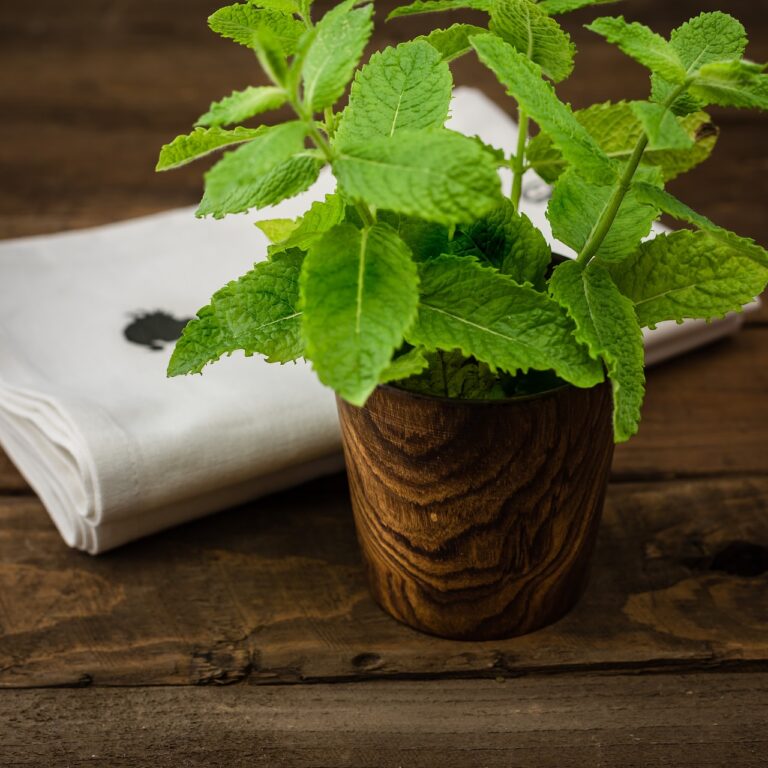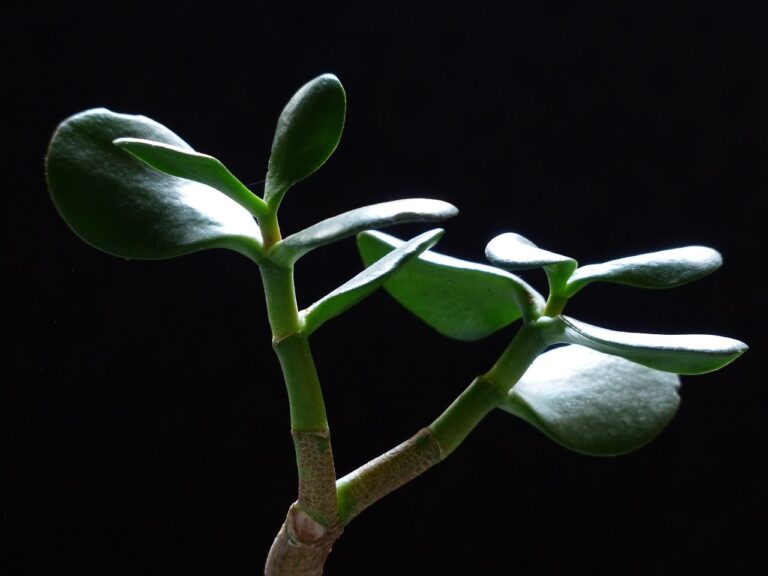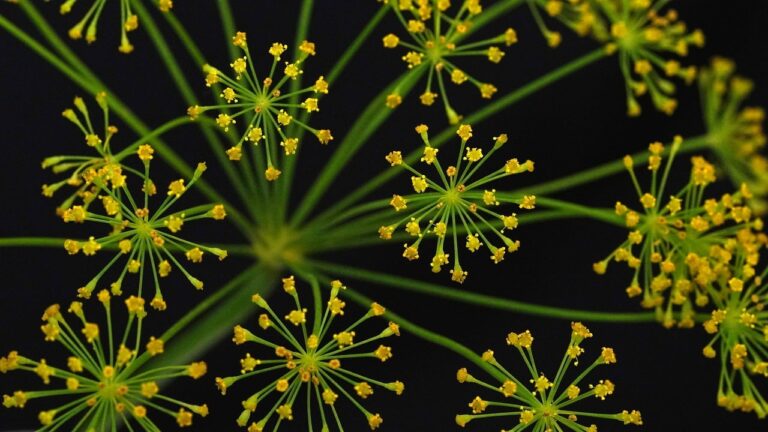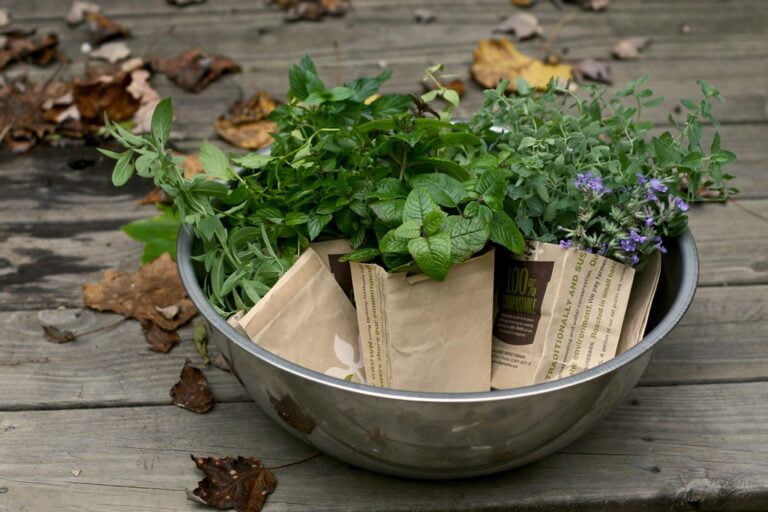Guide to Propagating Basil Successfully
I’ll show you how to propagate basil successfully for a thriving herb garden. Start by choosing healthy 4-6 inch stem cuttings with no damage. Cut just below a leaf node and remove lower leaves. Place in water or soil with rooting hormone for best results. Monitor growth, changing water every 1-2 days. Keep in indirect light and mist daily. Roots typically develop in 2-4 weeks. Once roots are 1-2 inches, transplant into nutrient-rich soil with good drainage. Water regularly and provide ample sunlight. Following these steps will set you on the path to successful basil propagation.
Selecting Healthy Basil Stem Cuttings
To guarantee successful propagation of basil, I typically choose stem cuttings that measure between 4 to 6 inches in length, showing no signs of disease or damage, and featuring at least two sets of leaves to support robust root development. When selecting basil cuttings for propagation, it is essential to examine them carefully. Healthy cuttings are essential for successful root formation. I make sure that the stems I choose are vibrant in color, firm to the touch, and free from any spots, discoloration, or pest damage.
Moreover, the presence of at least two sets of leaves on the stem is crucial as these leaves provide the necessary nutrients for root development. Leaves play a vital role in photosynthesis, producing energy that aids in the growth of new roots. Additionally, I look for stems that are not flowering, as flowering stems can divert energy away from root growth, potentially hindering successful propagation.
Proper hydration is also key in preparing the selected stem cuttings for propagation. Before planting them in a suitable growing medium, I make sure the cuttings are well hydrated by placing them in a glass of water. This step promotes water uptake and helps the cuttings remain turgid during the initial stages of root development. By paying attention to these details when selecting basil stem cuttings, I set the stage for a successful propagation process.
Proper Cutting Techniques for Basil Propagation
When propagating basil, it’s essential to cut 4-6 inch stem sections just below a leaf node and strip the lower leaves for best root growth. Using rooting hormone can improve the rooting process, especially if you choose to propagate in water. Proper cutting techniques are key to successful basil propagation, ensuring healthy new plants for your herb garden.
Cutting Basil Stems
Choosing mature basil stems is crucial for successful propagation, ensuring optimal growth outcomes. When trimming basil stems, make a clean cut just below a leaf node to promote root development. Removing lower leaves from the cutting prevents them from being submerged in water or soil, decreasing the risk of rot. After preparing the cutting, place it in water or moistened potting mix to foster root growth. Monitor the cutting closely for any signs of root development, which typically emerges within 10-14 days when using water propagation. By following these steps diligently, you establish the foundation for strong root growth and successful propagation of your basil plants.
Using Rooting Hormone
As we advance to discussing the use of rooting hormone in basil propagation, it’s essential to note that employing proper cutting techniques is vital for maximizing the benefits of this growth stimulant. When propagating basil, taking 4-6 inch stem cuttings just below a leaf node is key for successful propagation using rooting hormone. Dip the basal end of the basil cutting into the rooting hormone powder to promote root development. Rooting hormone contains auxins that encourage root growth, expediting the rooting process and boosting the success rate of propagating basil from cuttings. By following these steps and ensuring precise application of the hormone, you can greatly improve the root growth and overall success of your basil propagation endeavors.
Water Propagation
For successful water propagation of basil, start by selecting healthy 4-6 inch stem cuttings. Remove the lower leaves to prevent rotting and place the cuttings in clean water, ensuring only the stem is submerged. Changing the water every 1-2 days is important to maintain freshness and promote root growth. Roots typically emerge from the basil cuttings in about 10-14 days when propagated in water. This method allows for the freshly cut basil to develop roots and grow successfully. By following these steps, you can easily root basil cuttings and grow basil from cuttings with a high success rate. Just remember to keep the water fresh and watch for those roots to grow!
Preparing Basil Cuttings for Rooting
When preparing basil cuttings for rooting, it is essential to select healthy stems that are 4-6 inches long. Trim excess leaves from the lower part of the cutting to prevent submersion in water or soil. Make sure there are at least two leaves at the top for best growth support during the rooting process.
Select Healthy Stems
To successfully prepare basil cuttings for rooting, start by carefully selecting healthy stems that show no signs of disease or damage. Opt for non-flowering stems that are at least 4-6 inches long, avoiding woody or tough growth that may hinder rooting. Look for stems with several sets of leaves, as these are essential for successful propagation. Healthy stems provide the best chance for the development of new roots and the growth of propagated basil. Make sure the selected stems come from mature basil plants and place them in indirect light to promote root formation. By choosing the right stems, you set the stage for a successful propagation process that will lead to thriving basil plants.
Trim Excess Leaves
I typically prune excess leaves from the lower portion of the stem when preparing basil cuttings for rooting. By doing this, I guarantee that the plant’s energy is focused towards root development rather than sustaining unnecessary foliage. Leaving a few leaves at the top of the cutting allows the plant to continue photosynthesizing while it establishes roots. Pruning excess leaves also helps in reducing transpiration, aiding the cutting in retaining essential moisture during the rooting process. Properly pruned basil cuttings have a higher chance of successfully developing roots and thriving as new plants. This step is vital in the basil propagation process as it establishes the foundation for healthy root growth and overall plant establishment.
Water Propagation Method for Basil
For successfully propagating basil using the water method, start by placing clean cuttings in a container filled with water. It is important to change the water every 1-2 days to maintain a healthy environment for root development. Roots typically emerge from basil cuttings in water within 10-14 days, a sign that your propagation is successful. To aid in this process, mist the cuttings daily to make sure the humidity levels are ideal for root development.
During this time, it is vital to monitor the growth of the roots. Once they reach a length of 1-2 inches, it is time to move the cuttings into pots with moistened potting mix to encourage further growth. This method allows the newly rooted basil plants to acclimate to soil while continuing to establish themselves.
Water propagation is a straightforward and effective way to propagate basil, offering a close look at the development of roots before planting them into soil. By following these steps and providing the necessary care, you can successfully propagate basil using the water method, ensuring a fresh supply of this aromatic herb for your culinary endeavors.
Soil Propagation Method for Basil
Utilizing the soil propagation method for basil involves selecting 4-inch cuttings from mature basil plants. These cuttings should be free from flowering stems as it improves the likelihood of successful rooting in soil. Once you have your cuttings, insert them into moistened potting soil, making sure the top leaves are above the surface for ideal growth conditions. It’s important to keep the soil consistently moist, so watering every few days is essential to support root development.
To create a greenhouse-like environment that promotes growth, cover the pot with a clear plastic bag to maintain humidity levels. This step helps to create an ideal setting for the cuttings to take root. Roots typically begin to develop within 2-4 weeks when propagating basil in soil. Once you notice well-established roots, you can transfer the rooted basil cuttings to your garden or containers for continued growth.
Remember to choose a nutrient-rich potting mix to provide the new basil plants with essential nutrients for healthy development. Monitoring the soil moisture, ensuring adequate sunlight, and transferring the rooted basil once established are key steps in successfully propagating basil using the soil method.
Monitoring Rooting Progress of Basil Cuttings
Monitoring the progress of rooting basil cuttings is essential to guarantee successful propagation. When propagating basil from cuttings in water, it typically takes 10-14 days for roots to develop. To guarantee the health of the roots, it’s critical to regularly change the water, providing the cuttings with the necessary nutrients for growth. Maintaining a humid environment around the cuttings is also crucial for successful root formation.
During the rooting process, it’s significant to monitor the basil cuttings for any signs of wilting. Wilting can indicate that the cuttings are not receiving enough water or that the roots are unable to take up an adequate amount. Additionally, watch out for any signs of rot, which can be caused by overwatering or poor ventilation.
As the roots begin to grow and reach a length of 1-2 inches, the basil cuttings are ready to be transferred into moistened soil. At this stage, continue to monitor the moisture levels in the soil to guarantee the newly formed roots can establish themselves firmly in their new environment.
Transplanting Rooted Basil Cuttings
When transplanting rooted basil cuttings, make sure the soil has good drainage to support further growth and development. It’s important to select a nutrient-rich soil mix that provides adequate aeration for the new basil plants. This will help the transplanted cuttings establish themselves and thrive in their new environment.
After transplanting, it’s vital to water the basil cuttings regularly. Maintaining proper soil moisture levels is essential for the success of the transplanted basil. Be cautious not to overwater, as this can lead to root rot, but also avoid letting the soil dry out completely.
Place the transplanted basil cuttings in a sunny location. Basil thrives in sunlight, so providing sufficient light will encourage healthy growth and development. A sunny spot will also help the plants develop their characteristic flavor and aroma.
Throughout the transplanting process, monitor the basil cuttings for any signs of stress or wilting. Adjust the care provided as needed to ensure the transplanted basil adapts well to its new home. With well-draining soil, regular watering, and ample sunlight, your new basil plants should flourish and provide you with a bountiful harvest.






